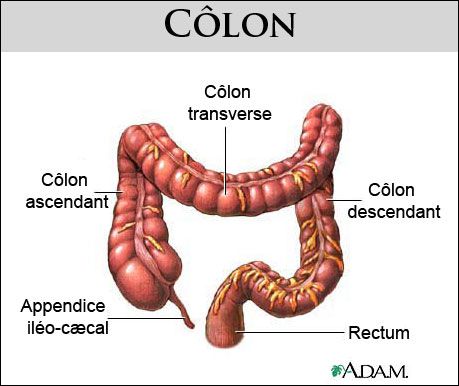-
 Cyberspace
Cyberspace
-
 InVS
InVS
-
 Dark background microscope
Dark background microscope
-
 Pneumoconiosis
Pneumoconiosis
-
 Hyperplasia
Hyperplasia
-
 Cochlea
Cochlea
-
 Astringent
Astringent
-
 GAK
GAK
-
 Carbonic anhydrase
Carbonic anhydrase
-
 Layout planning
Layout planning
-
 Hypocentre
Hypocentre
-
 Chelation
Chelation
-
 Breast
Breast
-
 Cyst
Cyst
-
 Combustion
Combustion
-
 Clementine
Clementine
-
 Volcanic rock
Volcanic rock
-
 W boson
W boson
-
 Colonoscopy
Colonoscopy
-
 Atlantic salmon
Atlantic salmon
-
 Pod
Pod
-
 Saturn
Saturn
-
 Horsepower
Horsepower
-
 Liver fluke
Liver fluke
-
 Channel D
Channel D
-
 Lactitol
Lactitol
-
 Polar mount
Polar mount
-
 Thermal insulator
Thermal insulator
-
 Centripetal force
Centripetal force
-
 Hydro-injector
Hydro-injector
Colon
The colon is part of the digestive system.
Function of the colon
The colon is also called the large bowel and follows the small bowel forming the last part of the digestive system. It has several parts:
- the caecum (from which the appendix begins);
- the ascending colon (right colon);
- the transverse colon;
- the descending colon (left colon);
- the sigmoid colon;
- and the rectum.
Its main role is to remove waste, absorb water, maintain water balance and absorb certain vitamins. The chyle which comes from the small intestine has already had almost all (90%) of its nutrients absorbed by the digestive system. Chyle mixes with mucus and intestinal bacteria in the colon to form faecal matter. Bacteria which can digest fibres form new molecules that the colon can then absorb.
Its pH is between 4.5 and 7.5.
Structure of the colon
The colon is 1 to 1.5 meters long and 4 to 8 centimetres in diameter (the rectum and caecum respectively). It is composed of several layers, from the inside to the outside consisting of:
- a mucosa which contains no valves or valvules;
- a highly vascularised innervated sub-mucosa;
- circular (internal) and longitudinal (external);
- smooth muscles and a serous lining (peritoneum).
 The colon or large bowel is the last part of the gastrointestinal tract. © www.health.allrefer.com
The colon or large bowel is the last part of the gastrointestinal tract. © www.health.allrefer.com
Latest
Fill out my online form.



